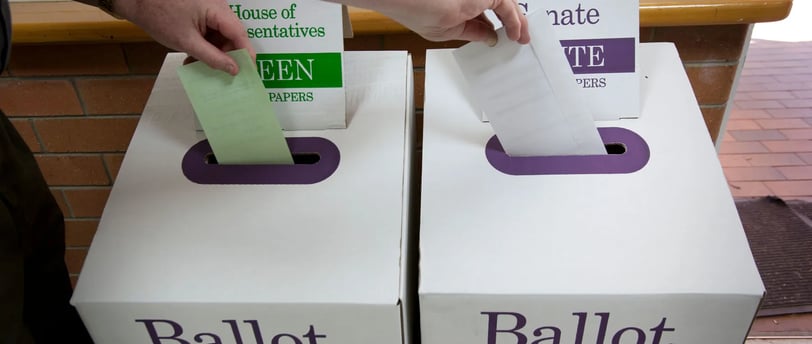Voting in Australia
An explainer on preferential voting.
Daryl McCullough
4/30/20253 min read


This post is a brief explainer on the Australian voting system, particularly preferential voting. Over the course of the current election campaign I have seen countless people on social media and in other contexts declaring that preferential voting is a major problem and "undemocratic" because it often sees the person who received the highest "primary" vote (first preference) end up not being elected... The truth however is quite different.
1 The Voting System
A lot of comments on news sites, social media and blogs indicate that we should dump the preferential voting system, and move to a first past the post model. Let’s look at these two voting systems, and decide if the preferential system is so bad after all.
Simple Majority Voting (First Past the Post)
First-Past-The-Post Voting, more correctly known as Simple Majority voting, is the most popular voting system employed throughout the democratic world. However it is not used in elections to any Australian house of Parliament.
Voters place a tick or a cross against the name of only the candidate they support.
To win a candidate needs to secure a higher total of votes than any other candidate. This is also known as a "plurality". There is no requirement to secure an absolute majority, merely a simple majority.
A winning candidate may secure only a minority of the vote. For example a vote may take place with three candidates – Candidate A receives 42% of the vote, Candidate B Receives 40% and Candidate C receives 18% of the vote. In this situation candidate A is declared the winner despite the majority (58%) of people wanting to elect someone else.
Preferential System:
Voters are required to place the number "1" against the candidate of their choice, known as their "first preference."
Voters are then required to place the numbers "2", "3", etc., against the other candidates listed on the ballot paper in order of preference.
The counting of first preference votes, also known as the "primary vote", takes place first. If no candidate secures an absolute majority of primary votes, then the candidate with the least number of primary votes is "eliminated" from the count.
The ballot papers of the eliminated candidate are then examined and re-allocated amongst the remaining candidates according to the number "2", or "second preference" votes.
If no candidate has yet secured an absolute majority of the vote (50%+1), then the next candidate with the least number of primary votes is eliminated. This preference allocation continues until there is a candidate with an absolute majority. Where a second preference is expressed for a candidate who has already been eliminated, the voter's third or subsequent preferences are used.
It ensures that only a candidate with the support of an absolute majority of the electorate can win, eliminating the possibility of minority winners. Put another way, the winning candidate is the "most preferred" or "least disliked" candidate.
The key for me is that the preferential voting system ensures that only a candidate with the support of the majority of the electorate can be elected. The only other way to do this would be to have a series of run off elections until a candidate achieved 50% +1 of the vote (which achieves the same result as preferences, but requires multiple elections, huge amounts of time and money). If we want politicians who are elected by a majority of the electorate then the preferential system is clearly the best. The only benefit to the first past the post system is that it simplifies the voting and counting process.
2 A vote for the X is a vote for Y!
One of the most common things I have seen during this election campaign is people declaring that ‘a vote for the Greens is a vote for Labor’ and a vote for "One Nation is a vote for Dutton"!. The people who make these claims demonstrate a high level of ignorance about the preferential system. The fact is people vote how they want to vote, whether or not a party recommends that someone order their preferences a certain way is irrelevant, once in the booth people vote the way they want to vote. If a person votes 1 for the Greens and 2 for the Liberal Party, their vote is certainly not going to be a vote for Labor!
Yes the majority of Greens voters preference Labor, just as the majority of One Nation voters preference the coalition, not because they have to, but because those parties are the next closest match for the political views held by those respective voters. If the Greens voter can’t get their first preference Greens member elected, doesn’t it make sense that their second preference would be to the party who next most closely matches their political leaning (in this case left leaning politics)? Likewise with the One Nation voter – it just makes sense that they would preference another right leaning/conservative party if they can't get their favoured candidate elected.
Put simply Australia's preferential voting system is by far the most democratic option. It is not perfect, but if you are concerned about genuine democracy and ensuring that people who are elected have at least 50% of the electorate supporting them it is the best option.
Feel free to leave a comment and let me know your thoughts.
All content copyright 2024-2025, All rights reserved.
